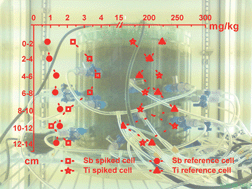Translocation of Sb and Ti in an undisturbed floodplain soil after application of Sb2O3 and TiO2nanoparticles to the surface†‡
Abstract
The pore

* Corresponding authors
a University of Koblenz-Landau, Institute for Environmental Sciences, Department of Environmental and Soil Chemistry, Landau, Germany
b
Federal Institute of Hydrology, Department of Aquatic Chemistry, Koblenz and Institute for Environmental Sciences, Department of Environmental Sciences, Landau, Germany
E-mail:
duester@bafg.de
Fax: +49 621 1306 5275
Tel: +49 621 1306 5363
c Deltares, Dept Soil & Groundwater Systems, Princetonlaan 6, Utrecht, The Netherlands
The pore

 Please wait while we load your content...
Something went wrong. Try again?
Please wait while we load your content...
Something went wrong. Try again?
L. Duester, C. Prasse, J. V. Vogel, J. P. M. Vink and G. E. Schaumann, J. Environ. Monit., 2011, 13, 1204 DOI: 10.1039/C1EM10056D
To request permission to reproduce material from this article, please go to the Copyright Clearance Center request page.
If you are an author contributing to an RSC publication, you do not need to request permission provided correct acknowledgement is given.
If you are the author of this article, you do not need to request permission to reproduce figures and diagrams provided correct acknowledgement is given. If you want to reproduce the whole article in a third-party publication (excluding your thesis/dissertation for which permission is not required) please go to the Copyright Clearance Center request page.
Read more about how to correctly acknowledge RSC content.
 Fetching data from CrossRef.
Fetching data from CrossRef.
This may take some time to load.
Loading related content
